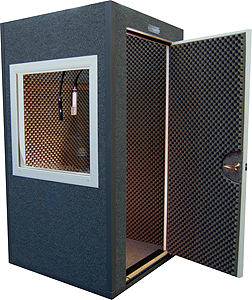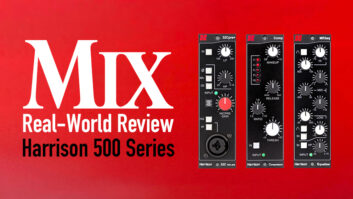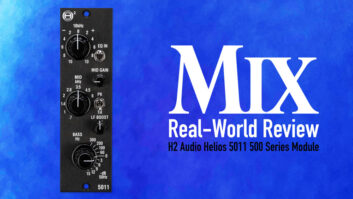
Figure 1: VocalBooth Gold Series rooms are typically treated acoustically with soy-based Auralex foam inside.
Not everyone can afford to build a studio from the ground up, and retrofitting an existing space to achieve isolation and flattering acoustics can be prohibitively time-consuming and disruptive. To address these issues, VocalBooth™ provides modular isolation booths for recording, mixing, broadcast and rehearsal. Two of the company’s lines—the Gold and Platinum Series—sport a rectangular footprint and parallel, opposing walls. You can also order a booth with a square footprint, but these reinforce standing waves. Platinum Series booths feature a “floating” floor and walls—essentially a room within a room—and purportedly offer greater isolation from the outside world as compared to the nonfloating Gold Series booths. (See Fig. 1.) Both types have roughly 90 percent of the inside surface area of their wall panels, ceiling and door treated with absorbent acoustic products: pressed polyester panels or 2-inch, open-cell, soy-based Auralex foam.
The Diamond Series is essentially a Gold or Platinum booth modified to have five splayed (non-parallel) walls. (See Fig. 2.) Splayed walls greatly reduce the strength of standing waves and flutter echoes that skew frequency and phase response. I recently visited VocalBooth’s factory, with SPL meter in hand, to test a couple of their “Platinum Diamond” (five-wall Platinum) and Gold Series booths.
MADE TO ORDER
VocalBooth will build booths in any dimensions. (Wall lengths must be specified in 1-foot increments.) Available wall lengths range from four feet (a booth for one person) to 18 feet—large enough to accommodate a four- or five-piece band or a mixing console and outboard gear. You can put the door and one or more windows on any wall. Ceilings are typically 82 inches high on the inside of the booth, but a higher ceiling can be ordered.
Floors are multilayered for increased isolation, and are typically finished with a wood-and-carpet base on the booth’s interior. You could order a booth with a hardwood interior floor that will provide a more live sound. Although a large Platinum booth with a hardwood floor can weigh around a ton, the weight per square foot is only 28 to 31 pounds—less than that of the existing building you’ll probably put the booth in. On the other hand, a 4×4-foot Gold Series booth weighs only about 875 pounds fully assembled. Doors are solid-core. The door seals create a bead of air between the door and jamb (or, in the case of the door sweep, the threshold) when the door closes, improving isolation.
VocalBooths come standard with electronic-ballast fluorescent lighting, which doesn’t induce noise into electronic circuits unless a mic is placed unreasonably close to the bulbs. All booths include a passive-active ventilation system. The fan-driven active component sucks warm air out of the booth while cooler air from outside the booth is drawn inside through a vent that reduces air speed and resonances. The ventilation channels have multiple bends along their traverse, attenuating both external and ventilation-induced noise. Cable-passage ports are also included.
Assembling a Platinum booth (and all but the smallest Gold Series booths, whether Diamond configuration or rectangular) requires two people. The booths are designed for quick multiple assembly/breakdown. Using only a screw gun with a Phillips head bit, two people can purportedly assemble a Gold booth in about 45 minutes. An optional caster wheelbase can be ordered for booths up to 10×10 feet in size.

Figure 2: VocalBooth Diamond Series rooms feature five splayed walls with optional floating floor and walls.
GOING GOLD OR PLATINUM
Platinum Series booths float their floors and walls by sandwiching 2-inch-thick, hypoallergenic, pressed-polyester batting between two layers of construction. All wall and ceiling seams, including in corners, have thin strips of mass-loaded vinyl to prevent sound leakage. The inside seams between wall panels are also covered with thin acoustic panels.
The custom Platinum Series booth I tested had walls that were additionally dressed on the inside with 2-inch-thick acoustic panels. These are made from spun and pressed polyester, which ages better than open-cell acoustic foam. Alternatively, your Platinum booth can be ordered with 2-inch soy-based Auralex foam.
Platinum Series booths are designed to prevent low frequencies entering from the outside world, and Gold Series booths are intended to keep high and mid frequencies from exiting the enclosure. Gold booth floors and walls are generally not floated. However, a “sub-floor” upgrade is available.
Gold Series walls are constructed of four different layers and are typically finished on the inside with Auralex foam. The 100-percent soy-based foam ensures no toxic out-gassing; it’s offered in one of 10 different colors and sports either a pyramid or rounded-tip profile. You can optionally replace the blown foam with pressed-polyester panels.
The two-pane windows for Gold Series booths have one fewer layer than the three-pane Platinum Series. The window assemblies for both series have a clear, thin vinyl laminate on the outermost window pane. A vacuum between window panes creates an inert environment that prevents condensation from forming.
AN OPEN AND SHUT CASE
I tested a large Platinum Diamond Special (custom-configured) booth with five splayed walls, each measuring between five and 10 feet in length. I also tested a standard 4×4-foot Gold Series booth. With a drummer and electric guitarist blasting away a few yards outside each booth, the highest SPL measurement was roughly 103 dB (C-weighted) just outside the door of each booth. Inside either booth, with its door firmly shut, the sound transmission loss (STL) was between roughly 19 and 20 dB. Subjectively, the music sounded only a tenth as loud inside the booth as compared to being just outside the door, with high and midrange frequencies being the most dramatically attenuated.
Bass frequencies were also attenuated quite impressively but were still very audible from inside either booth. Quite frankly, you’d probably have to accept much greater expense and fixed construction for better performance than a modular booth can provide at low frequencies. It takes tremendous mass to eliminate the transmission of bass frequencies through physical structures, which is why state-of-the-art recording studios with floating construction can easily cost six figures to build. Most people can (and do) get professional work done with far less isolation.
If your main goal is keeping bidirectional sound leakage between your studio and the outside world to a bare minimum, a VocalBooth room inside your building should provide outstanding isolation. VocalBooth’s rooms offer cost-effective, quick, comfortable and visually attractive acoustical solutions that don’t force irreversible construction on your existing home, studio or office space. Best of all, you can take the booth with you.
Mix
contributing editor Michael Cooperappears in a speaking role in an upcoming movie,
The Wait
, which stars Jena Malone and Luke Grimes.

Click on the Product Summary box above to view the VocalBooth product page.







